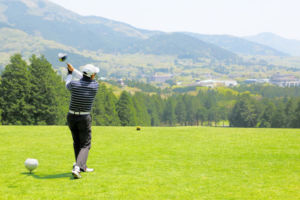Though golf could be challenging while you are learning the right techniques, the game could be very enjoyable and interesting once you have mastered the skills. One thing that makes golf difficult is that even a small detail might bring a significant effect on your shot.
And it all begins with your swing. If you hook or slice the ball, or find it hard to get the proper yardage, then this guide will show you some modern golf swing fundamentals.
The classic golf swing involves a lot of attention on the lower half of the body. Using the legs and the rotational motion of the hips to generate power in the golf swing.
A lot stress and movement was put on the back with this style of swing resulting in injuries to the back of many pro golfers and recreational golfers alike.
Today many golfers are playing into their 60’s at a high level because they have changed their style of swing to be a modern one.
The modern golf swing derives it’s power mainly from the upper half of the body. The golfer stands over the ball and there is more rotation in the shoulders. This is a compact upper body movement combined with the lower movement (with much less emphasis then the classic swing). The modern swing generates in general more golf swing speed then the classical older style swing.
What is the difference between classic and modern golf swing?
There are different ways to swing a golf club. But it can be basically divided into two main categories: classic and modern. A classic golf swing in the past requires your leading foot to raise at the end of a back swing to increase the hip’s rotation and reduce the torsional load on your spine.
The right arm of a right-hander stays close to his side on the back swing and the rotation on the shoulder is not much. The modern swing the golfer on his back swing has a space between his right arm and his body and the shoulders are rotated much more down toward the ball then the classic swing.
On the very top of the back swing the classic swing golfer has his shaft parallel with the ground and shoulders are past a 90 degree turn with a good amount of hip turn approx 45 degrees. The modern swing at the top of the back swing does not come to a parallel with his club shaft to the ground and his arm swing is going to be far less then the classic swing.
The modern swing at the top will have only about half the hip turn as the classic swing (22 degrees). On the downswing the classic golfer will slide his body forward thru the swing and after impact the right wrist will rotate over the left wrist (a very aggressive swing thru). On the downswing with the modern golfer does not slide his body as far forward as the classic golfer but the hips will rotate more and the right wrist will not rotate over the left.
The modern swing still has as much or more power then the classic swing in that the power is coming from the upper body and the hip turn. For the modern swing picture a coiled spring uncoiling from the compact upper body. Golf swing basics apply to both styles of swings.
Additionally, the modern style is involved with a more upright posture, which can help minimize shear pressure and lumbar disc forces. A modern golf swing requires both feet to stay flat firmly on the ground during the swing.
Also, you need to maximize the rotation of your shoulders versus your hip. This technique will result in increased velocity and raised torsional load on your spine.
Modern golf swing fundamentals
1. The stance
Start with placing your front foot a bit ahead of the golf ball and let the club rest near the center of the body. Make sure your feet are a bit wider than your shoulder-width apart. Next, get close to the ball enough so that the center of the clubface can reach the golf ball while your arms are out, relaxed and straight.
Avoid standing so close to the golf ball which can make you bend the elbows. Check the alignment between your shoulders and your feet. Make sure your front shoulder and back shoulder, as well as front foot and back foot, is directly pointed at the target. Lastly, slightly bend the knees and balance your weight on the feet.
2. The grip
No matter which grip style you choose, always make sure it is relaxed so that the clubhead can turn over easily during a swinging. This is important in ensuring better precision and distance.
In other words, try to keep your grip as natural and comfortable as possible. Here are the three most common types of grip in the modern golf swing:
– Baseball grip
This is a basic style that is quite similar to the way a baseball player holds a baseball bat. Place the left hand under the club and curve the fingers so that they securely grip it.
Make sure the club rests where your fingers meet your palm, and the left thumb must point straight down the golf club to its head.
– Overlap grip
Compared to the baseball grip, an overlap grip provides more stability. Start with your hands in a baseball grip. Rather than keeping the left index finger side by side and right pinky, lift up the right pinky. Then, move up the right hand and rest the right pinky on the index finger’s top or the joint between your left middle and left index.
– Interlocking grip
This is the most stable grip since it can interlock the right and left hands under the club. It is used by many famous golfers. Start with a baseball grip, then fit your left finger between the ring fingers and the right pinky’s joint. Also, take your right pinky and fit it between the middle fingers and left index. Make sure your left index and right pinky essentially hold in an X interlocking.
3. Swing the club
Once you have prepared a good posture and grip, it’s time to start a backswing. Basically, it has three different phrases:
– Phase 1: Move your hands straight and keep them close to the back leg. Make sure the front arm is straight.
– Phase 2: Continue a wrist break when you are moving the arms parallel with the ground. Make sure the club is roughly perpendicular with the left arm.
– Phase 3: Rotate the torso back so that the head of the club slightly travels behind the hands. The front arm should slightly bend in this last phase.
The bottom line
If you have mastered the basic aspects of golf, but need to enhance your swing skills, then make sure to adjust your grip, position, stance, swing, and body movement. With a bit of patience and practice, you will learn some modern golf swing fundamentals and improve your score on the golf course.
But keep in mind the classic style swing versus the modern swing. Neither swing is wrong or incorrect. It is the golfers choice and preference. As a golfer you can now experiment and refine with either style to see which golf swing feels the best for you. After practicing take it to the golf course to use. Above all make it fun and enjoy this great sport and hobby!


